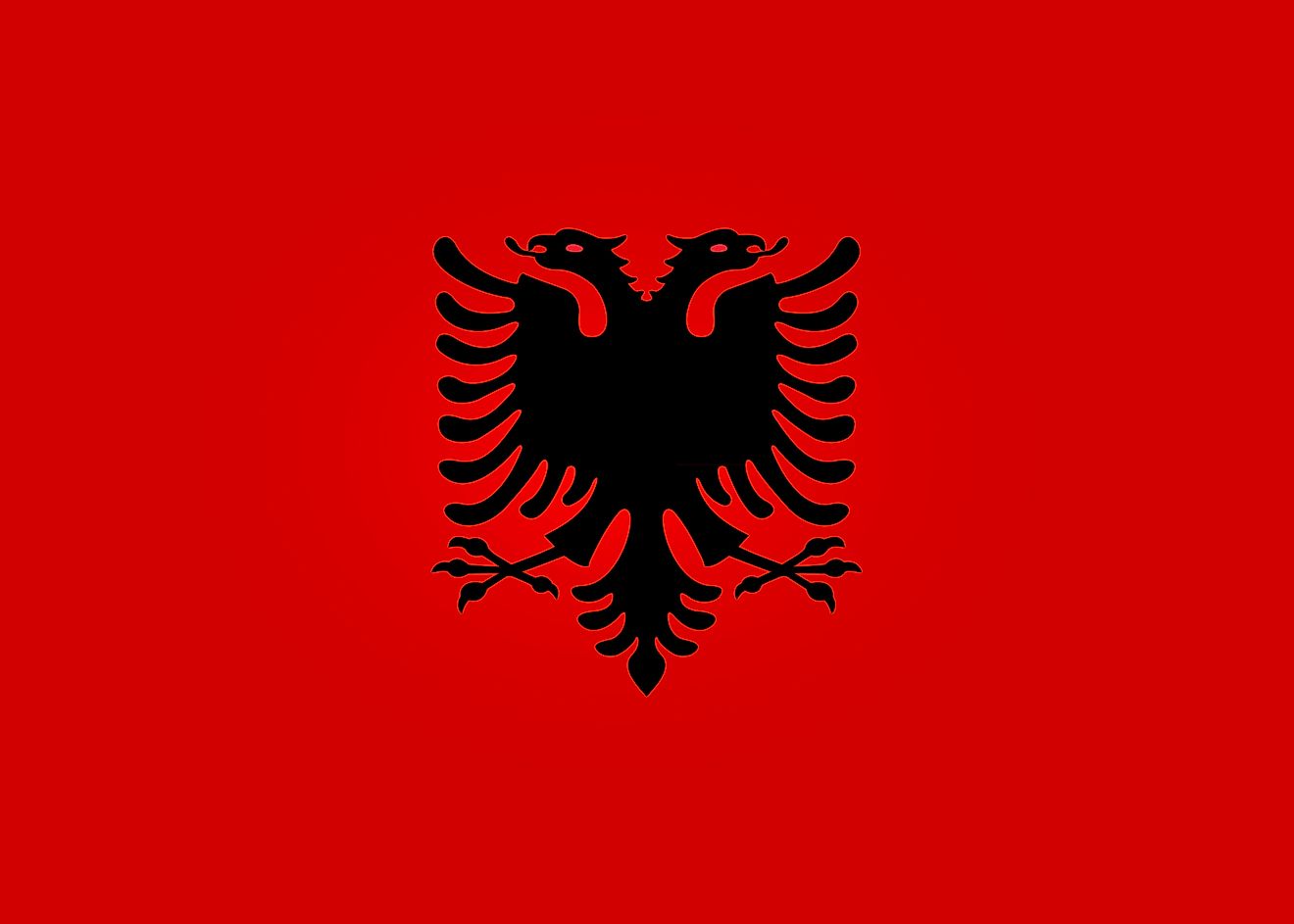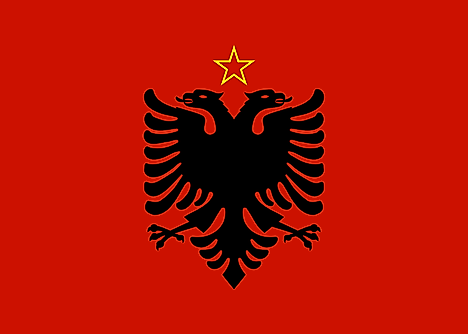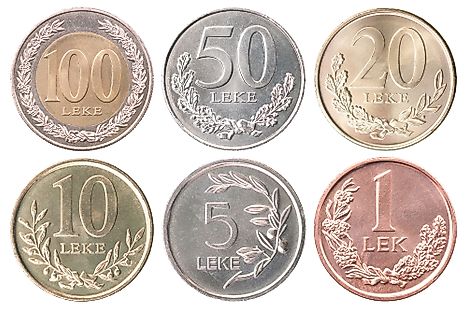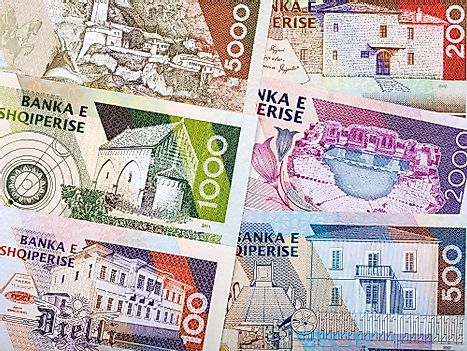Flags, Symbols & Currency of Albania

The National Flag of Albania named the Flamuri Kombëtar was adopted on January 11, 1946 (with a star in the design). On April 7, 1992, the star was removed. The current flag was designed by Sadik Kaceli a day before Albania was declared a People's Republic on January 11, 1946.
The flag features a red background with a double-headed eagle placed in the center, whose wings and talons extends towards the flag’s fly and hoist. The eagle is black in color, and the two heads face away from each other and have their tongues out. The red color on Albania’s national flag is said to represent the virtues of valor, strength, and courage among the people of Albania
This design is traced back to Skanderbeg (Gjergj Kastrioti), an Albanian Christian, and a 15th century Turkish general. He used the Byzantine two-headed eagle on his seals, hence the Albanian flag. Note that Albanians call their country Shqipëria, meaning "Land of the Eagle."
History Of The Albanian Flag
The designs of both the flag and the coat of arms are based on the seal of Skanderbeg, who was the monarch who ruled over Albania in the 15th century. Skanderbeg is revered in Albania due to the battles he led against other European kingdoms, particularly against the Ottoman Empire, in which he fought for the sovereignty of Albania. The seal was modeled after the coat of arms of Skanderbeg’s Karstrioti family, one of Albania’s noble families. The flag was first officially used in the region in 1912, and the earlier one was adopted in 1443. The King’s helmet symbolized the monarchy and first appeared in the Albanian flag which was in use between 1928 and 1939. The helmet was removed from the country’s flag when it was under German occupation during the Second World War. A yellow five-pointed star was incorporated in the flag’s design when Albania was part of the Soviet Union between 1946 and 1992.
Symbols of Albania
National Coat Of Arms

Albania adopted its current coat of arms in 1998, replacing the older emblem that was adopted in 1993. The design of Albania's coat of arms mirrors its national flag as it also bears the double-headed black eagle centered on a red field. The margin of the coat of arms features a golden stripe. Additionally, the coat of arms also features a helmet which is placed directly above the double-headed black eagle. The helmet is modeled after the helmet of Skanderbeg and has the golden likeness of a billy goat’s head on top. The helmet was added to the design of the coat of arms in 1998. The symbolism of the red color on the coat of arms is similar to that of the national flag, representing courage and strength among the people. The golden border is said to represent the country's wealth.
National Motto
"Ti, Shqiperi, me jep nder, me jep emrin Shqiptar" ("You Albania, give me honor, give me the name Albanian")
National Anthem
- Anthem Title: “Himni i Flamurit”/ “Betimi mi flamur” (“Pledge to the Flag”)
- Composer: Ciprian Porumbescu
- Lyricist: Asdreni (Aleksander Stavre Drenova)
- Date of Adoption: November 28, 1912
The national anthem of Albania is “Himni i Flamurit”/ “Betimi mi flamur” (“Pledge to the Flag”). Asdreni (Aleksander Stavre Drenova) – an Albanian poet had penned the lyrics, with the Romanian composer - Ciprian Porumbescu composing the music. The national anthem was officially adopted on November 28, 1912. The hymn was first published as a poem in an Albanian newspaper called Liri e Shqipërisë (Freedom of Albania), on April 21, 1912. It was so well appreciated by the Albanians, that during the Albanian Proclamation of Independence, the Albanian Flag was raised using its music in Vlore, Albania in 1912.
“Himni i Flamurit”/ “Betimi mi flamur” (Albanian)
Rreth flamurit të përbashkuar
Me një dëshirë e një qëllim,
Të gjith' atij duke u betuar
Të lidhim besën për shpëtim.
Prej lufte veç ai largohet
Që është lindur tradhëtor,
Kush është burrë nuk friksohet,
Por vdes, por vdes si një dëshmor!
Në dorë armët do t'I mbajmë,
Të mbrojmë atdheun në çdo kënd,
Të drejtat tona ne s'I ndajmë;
Këtu armiqtë s'kanë vënd!
Se Zoti vetë e tha me gojë
Që kombe shuhen përmbi dhe,
Po Shqipëria do të rrojë;
Për të, për të luftojmë ne!
O Flamur, flamur, shenj' e shenjtë
Tek ti betohemi këtu
Për Shqipërinë, atdheun e shtrenjtë,
Për nder' edhe lavdimn e tu.
Trim burrë quhet dhe nderohet
Atdheut kush iu bë therror.
Përjetë ai do të kujtohet
Mbi dhe, nën dhe si një shenjtor!
“Pledge to the Flag”
Around our flag we stand united,
With one wish and one goal,
A sacred oath we bestow upon it
Proclaiming loyalty for our salvation.
From war abstains only he,
Who a traitor is born,
He who is a true man is not frightened,
But dies a martyr to the cause.
With weapons in our hands a-brandished,
We will defend our fatherland,
Our sacred rights we’ll not relinquish,
The foe has no place in our land.
For God himself proclaimed:
Some nations of the earth shall wane,
But Albania will live, will thrive Albania.
For her, for her, we fight.
O Flag, flag, you sacred symbol
Upon you we now swear
For Albania, our dear fatherland
For honour and your glory.
Brave man is named and honoured
The one who sacrificed himself for the fatherland
Forever he will be remembered
On earth and under as a saint!
The Currency of Albania is the Albanian lek
The official currency of Albania is the Albanian lek. Its plural form is often written as “lekë”. It was formerly subdivided into 100 qindarka but qindarka is no longer used. Although there is a considerable circulation of the euro in Albania, the Albanian lek still dominates the country's financial sector and is widely accepted in the country for most payments and other forms of transactions.
The Albanian lek was named in honor of Alexander the Great. In Albania, the name Alexander is often shortened as "Leka." The observe side of the 1 lek coin has a portrait of Alexander, while the reverse side depicts him on a horse.
The lek was introduced in Albania on February 16, 1926.
Coins
When the Albanian lek was introduced, the first coins were made of bronze in denominations of 5 and 10 qindars, whereas nickel was used for 25 and 50 qindar, as well as 1 lek, and silver denominations were used for 1, 2, and 5 franga ar. In 1935, bronze was used in the denominations of 1 and 2 franga ar. The coins depicted distinct neoclassical motifs influenced by Victor Emmanuel III, an Italian king who was also a coin collector. Aluminum coins in the denominations of 5, 10, 20, and 50 qindars all depicting socialist state emblems were introduced in 1965. In 1969, a similar series of aluminum coins was released in commemoration of the 1944 liberation from fascism. The third set of coins was introduced in 1995 and 1996 in the denominations of 1, 5, 10, 20, and 50 lekë. The 100 lekë was launched in 2000. The 1 lek coin is now hardly in use in the country.
Banknotes
Banknotes in 1, 5, 20, and 100 franga ar denominations were introduced by the National Bank of Albania in 1926. In 1945, regular notes were circulated in the denominations of 1, 5, 20, 50, 100, and 500 franga. The lek was established as the major denomination in 1947, with banknotes in the denominations of 10, 50, 100, 500, and 1000 leke. In 1997, a new series of banknotes was introduced in the denominations of 100, 200, 500, 100, 200, and 500 leke.
Historical Currencies of Albania
Before World War I, the Ottoman Turkish piastre was used as the currency of albania. However, the conquest of the country by the military of some of the continental powers led to the adoption of the gold franc as currency. Since its introduction in 1926, the Albanian lek has served as the country’s official currency. Between 1946 and 1965, the lek's value was pegged to the Soviet ruble at an exchange rate of 12.5 lekë to 1 ruble. After 1965, an inequality was created by the revaluation of the ruble, leading to the issuance of a second lek that was equal to 10 old leke. In 1992, lek valuta, which was equal to 50 lekë, was introduced. Between 1926 and 1939, the Albanian gold currency was referred to as franga. The franga was worth 5 Albanian leke.










